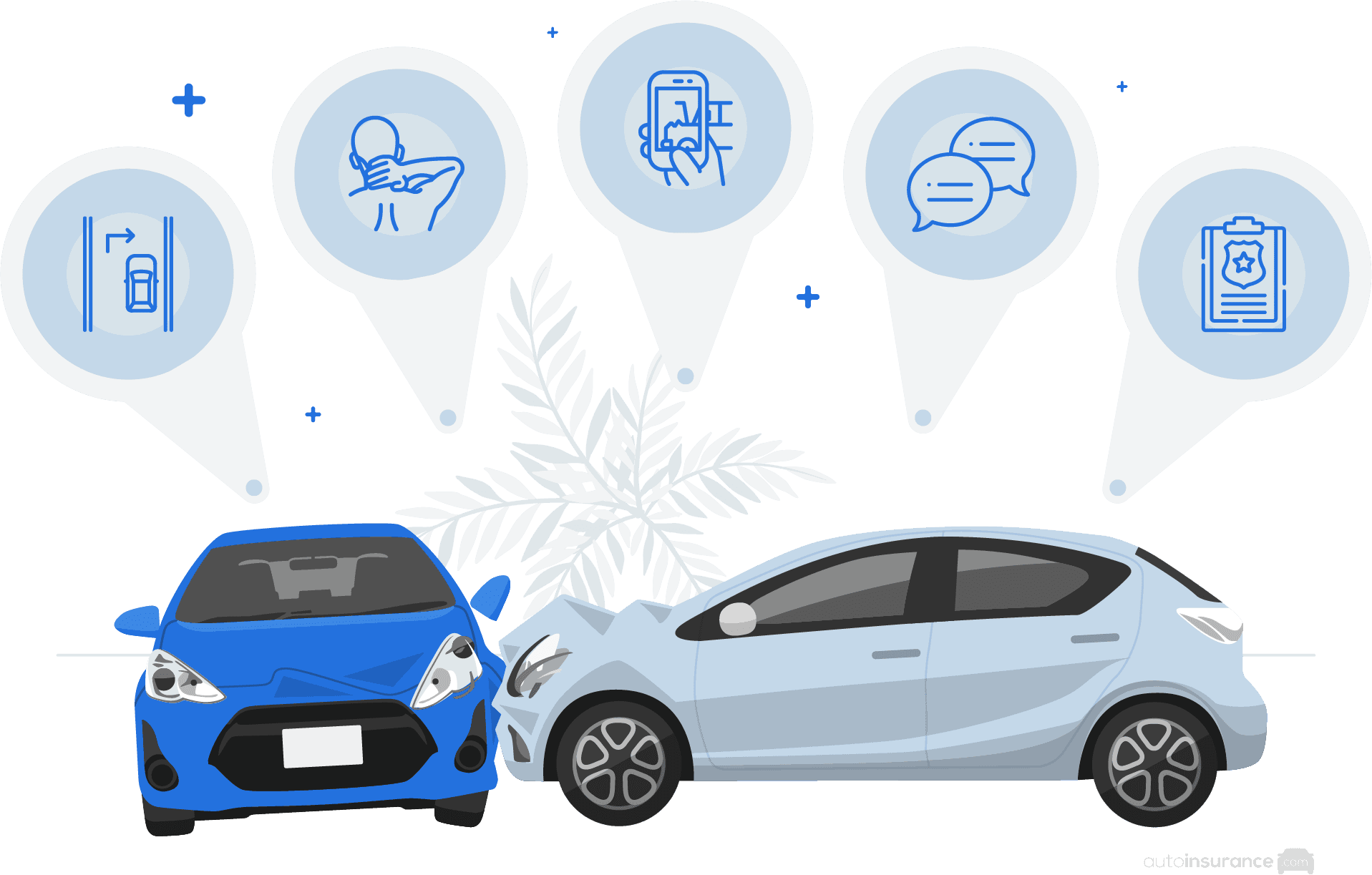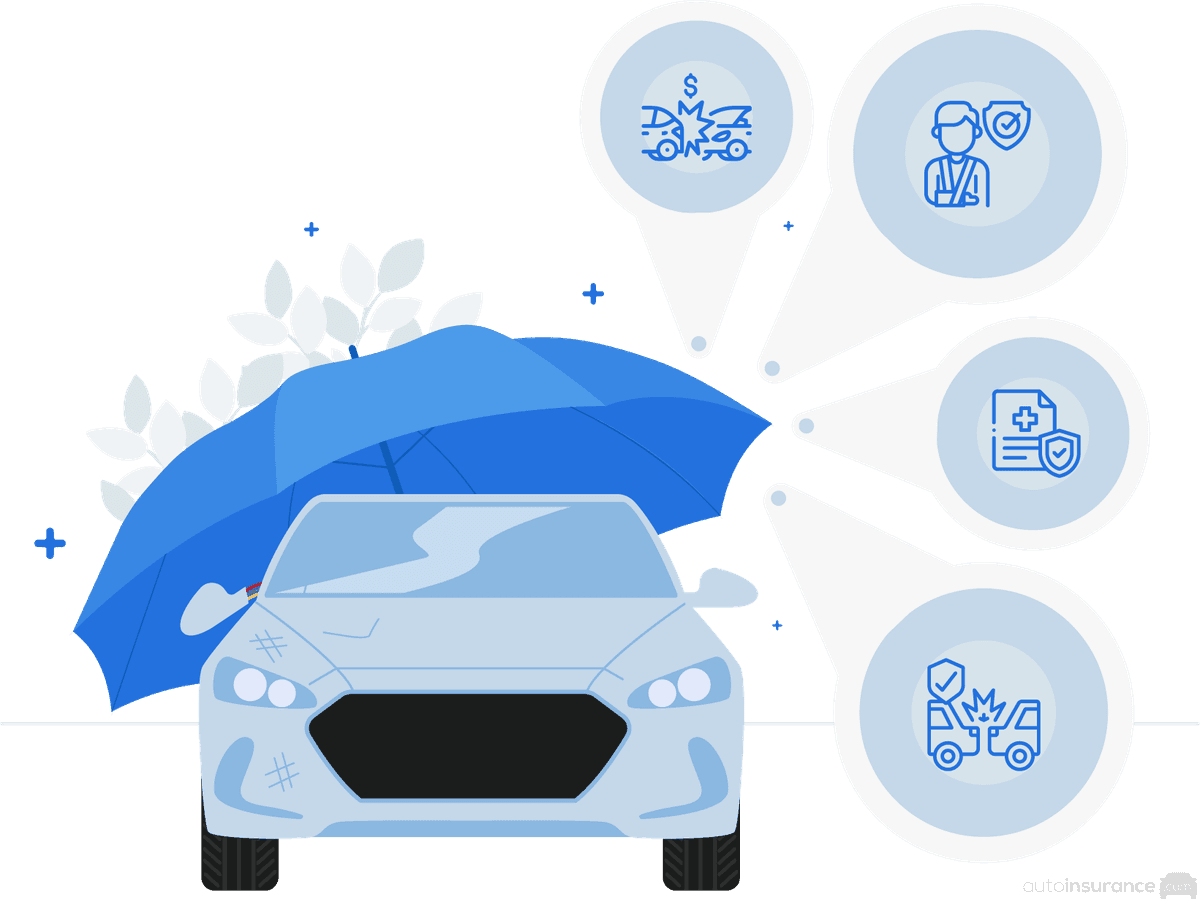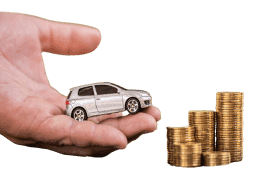
What to Do if a Car Accident Is Your Fault
First of all, don’t panic; this is why you have insurance in the first place.
Get quotes from providers in your area

Maybe you were texting and driving, or maybe you forgot to check your blind spot before merging lanes. Whatever the reason, if a car accident is your fault, it’s important to face it head-on so you can file a claim and have your insurance provider contribute to any expenses connected to the accident. If you’re involved in an at-fault accident, make sure to gather the necessary information to take responsibility and avoid lawsuits.

What to Do if a Car Accident Is Your Fault
Been in an at-fault accident? First, breathe, and then follow these steps:
- Pull over. Pull your car over to the side of the road or another safe place near the scene of the accident.
- Check for injuries. Make sure everyone is OK physically; if someone is injured, call 911 for an ambulance.
- Check the damages. Check your vehicles for damages, and take pictures if you find any.
- Exchange information. Get the other driver’s name, their address, contact information like their email address or phone number, and their car’s make and model, registration, and insurance information. Record what time the incident occurred, the date, and the weather. Exchange your information with the other driver.
- File a report with the police. Either call the police to come to the scene or go to the nearest police department to file an accident report. Remember to get the names and badge numbers of all the police officers involved and get a copy of the accident report to include in your claim. You’ll need this police report when you file a claim.
How to Work With Your Auto Insurance Company
Even if an accident is your fault, you should still contact your insurance company to explain the details rather than waiting for a third-party claim to get submitted to your provider.
NOTE
A third-party car insurance claim is a claim that the first party, the one not at fault, submits to the at-fault “third” party’s insurance provider.
- Submit your claim. Contact the at-fault party’s insurance provider first, which is your insurance provider in this case. Give your agent the details of the accident, and they’ll contact the other party’s insurer and start the fault-determination process.
- Work with an adjuster to determine fault in a car accident. Either an insurance adjuster or a claims representative will examine the evidence of the accident and determine who is at fault. The adjuster could find that you’re partially or fully at fault, which will determine your fault-based payments for medical bills and property damage.
- Pay for damages. If the adjuster determines the accident is your fault, your company will pay the other party either directly or through a repair shop.
>> Related: Indemnity Insurance for Cars
What Not to Do if a Car Accident Is Your Fault
Equally important as what to do after a car accident is what not to do after a car accident.
- Don’t leave the scene. You could get in legal trouble for doing a “hit-and-run,” although the exact punishments differ by state.
- Don’t handle it personally. Don’t try to work out a deal with the other party; go through your respective insurance providers.
- Don’t give false information. You could also get in trouble by giving the other driver false contact, insurance, or registration information.
- Don’t try to treat the injured person. Unless you have first-aid training, don’t try to help someone with their injuries post-accident.
- Don’t try to move the injured person. Moving the other person could make things worse, unless they’re in a life-threatening situation.
- Don’t discuss anything with the other party. Aside from exchanging information, don’t argue or discuss anything with the other party, as your words could be used against you in court.
- Don’t wait too long to file your claim. If a car accident is your fault, you’ll want to cover the other person’s personal injuries or property damage through your insurance rather than out of pocket. However, if you wait too long, you could miss the statute of limitations on these claims, which differ by state. See the chart below for details.
| State | Personal injury claims statute of limitations (in years) | Property damage claims statute of limitations (in years) |
|---|---|---|
| Alabama | 2 | 2 |
| Alaska | 2 | 2 |
| Arizona | 2 | 2 |
| Arkansas | 3 | 3 |
| California | 2 | 3 |
| Colorado | 3 | 3 |
| Connecticut | 2 | 2 |
| Delaware | 2 | 2 |
| District of Columbia | 3 | 3 |
| Florida | 4 | 4 |
| Georgia | 2 | 4 |
| Hawaii | 2 | 2 |
| Idaho | 2 | 3 |
| Illinois | 2 | 5 |
| Indiana | 2 | 2 |
| Iowa | 2 | 5 |
| Kansas | 2 | 2 |
| Kentucky | 1 | 2 |
| Louisiana | 1 | 1 |
| Maine | 6 | 6 |
| Maryland | 3 | 3 |
| Massachusetts | 3 | 3 |
| Michigan | 3 | 3 |
| Minnesota | 2 | 6 |
| Mississippi | 3 | 3 |
| Missouri | 5 | 5 |
| Montana | 3 | 2 |
| Nebraska | 4 | 4 |
| Nevada | 2 | 3 |
| New Hampshire | 3 | 3 |
| New Jersey | 6 | 6 |
| New Mexico | 3 | 4 |
| New York | 3 | 3 |
| North Carolina | 3 | 3 |
| North Dakota | 6 | 6 |
| Ohio | 4 | 4 |
| Oklahoma | 2 | 2 |
| Oregon | 2 | 6 |
| Pennsylvania | 2 | 2 |
| Rhode Island | 3 | 10 |
| South Carolina | 3 | 3 |
| South Dakota | 3 | 6 |
| Tennessee | 1 | 3 |
| Texas | 2 | 2 |
| Utah | 4 | 3 |
| Vermont | 3 | 3 |
| Virginia | 2 | 5 |
| Washington | 3 | 3 |
| West Virginia | 2 | 2 |
| Wisconsin | 3 | 6 |
| Wyoming | 4 | 41 |

What Damages Are Covered in At-Fault Accidents?
The damages covered in at-fault accidents depend on your state and coverage, but here’s what they look like in general.
Their Damages
- Property damage: You’ll pay for the other person’s property damage, whether that’s to their vehicle or other property like a fence.
- Bodily injury: You’ll also pay for the other person’s bodily injuries, if any.
Your Damages
- Medical coverage: If you have medical coverage, your insurance provider will cover the costs of your injuries as well as the other party’s.
>> Related reading: Does Car Insurance Cover Ambulance Rides?
FYI
If you live in a no-fault state, each party will pay for their own medical expenses, but the at-fault party will still pay for the other party’s property damage.
- Collision coverage: Another optional coverage is collision coverage, which would cover your vehicle’s damages in the event of an at-fault accident after you pay your collision deductible, if you haven’t already.
Will the Accident Affect My Car Insurance Rates?
Typically, unless your accident falls under an accident forgiveness policy, at-fault accidents will affect insurance rates. The exact percentage will depend on the severity of the accident, the insurance provider, and your driving history. Learn more about what affects car insurance rates.
All About Fault
When it comes to car accidents, fault matters, even if you live in an ostensibly “no-fault” state, as detailed below. But what is “fault” in the first place?
Definition of Fault
In civil law, the legal definition of “fault” is an improper omission or act that injures another party through rashness, ignorance, or negligence.2 In car accidents, fault could be determined by events like road rage, texting and driving, or not looking behind you before you pull out of a parking spot.
Why Fault Matters
Fault matters because it determines who pays for damages from a car accident. However, exactly which damages are paid depends on the state’s laws.
At-Fault vs. No-Fault Accidents and States
You may live in a no-fault state like Florida, but what does that really mean? In no-fault states, everyone pays for their own medical coverage, while the at-fault party pays for the other party’s property damages. In at-fault states, the at-fault party pays for both coverages for the other party. These are the no-fault states:
- Arkansas
- Delaware
- Florida
- Hawaii
- Kansas
- Kentucky
- Massachusetts
- Michigan
- Minnesota
- New Jersey
- New York
- North Dakota
- Pennsylvania
- Texas
- Utah
But note that in Pennsylvania, Kentucky, and New Jersey, you can choose whether or not you want no-fault insurance.3
At-fault accidents are accidents that occur in at-fault states, while no-fault accidents are accidents that happen in no-fault states. Make sure you know your state’s fault laws so you can determine how responsible you will be in the event of an accident.
Recap
Learn more about liability vs. no-fault coverage, or read our car insurance FAQs for even more information. If a car accident is your fault, you’ll want high limits on your bodily injury and property damage coverage, along with collision and medical coverage, whether or not they’re required in your state. Paying higher premiums now means paying less out of pocket down the road (no pun intended).
Citations
Dram Shop Laws and Liability for Drunk Driving Accidents. Justia. (2022).
https://www.justia.com/injury/negligence-theory/dram-shop-laws/What is FAULT? The Law Dictionary. (2022).
https://thelawdictionary.org/fault/What states have no-fault insurance? Nationwide. (2016, Nov).
https://www.nationwide.com/lc/resources/auto-insurance/articles/no-fault-insurance-states

